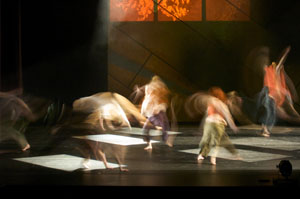5.) DANCE HISTORY Historical Precedents
Seeing, reading about and participating in dances from other historical moments and different cultures can enrich and enliven our own dance practices and choreographic visions. The study of a dance can help us to see how movement can both reflect and shape important questions about identity, aesthetic beauty, physical training regimes, the making of community, and the distribution of power within social groups. Because dance comprises the daily technical training of the dancer’s body as well as the final choreographic production, dance can help us trace the complex negotiations between somatic experience and cultural representation. Dancing is a way of thinking through the body. Studying a particular dance helps us to recognize how the choreographer understands his or her world.
Historical Precedents
The belief that dance could be an artistically expressive medium really gained momentum at the beginning of the twentieth century.  At that time, famous dancers such as Isadora Duncan, Loie Fuller, or Ruth St. Denis and Ted Shawn (to name only a few) revolutionized theatrical dance by insisting that dance could be a thoughtful pursuit. Like many early modern dancers throughout America at this time, these dancers created a physical language that focused on breath rhythms, the dynamic use of the torso, and the articulation of gestures that galvanized space in new and important ways. By asking audiences to see not only the movements of their arms and legs, but also the source of those motions in their torso, or even its initiation in the breath, these dancers created a new form of communication based in physical sensation and the kinesthetic. Together, they taught dance audiences to pay attention not only to enticing smiles and high leg kicks, but also to the somatic experience of the dancers onstage. Indeed, eventually these early modern dancers convinced audiences to see dancers not as pretty otherworldly objects onstage, but rather as subjects of their very human lives.
At that time, famous dancers such as Isadora Duncan, Loie Fuller, or Ruth St. Denis and Ted Shawn (to name only a few) revolutionized theatrical dance by insisting that dance could be a thoughtful pursuit. Like many early modern dancers throughout America at this time, these dancers created a physical language that focused on breath rhythms, the dynamic use of the torso, and the articulation of gestures that galvanized space in new and important ways. By asking audiences to see not only the movements of their arms and legs, but also the source of those motions in their torso, or even its initiation in the breath, these dancers created a new form of communication based in physical sensation and the kinesthetic. Together, they taught dance audiences to pay attention not only to enticing smiles and high leg kicks, but also to the somatic experience of the dancers onstage. Indeed, eventually these early modern dancers convinced audiences to see dancers not as pretty otherworldly objects onstage, but rather as subjects of their very human lives.
Class Activity: Researching Early Dancers
Briefly research one of the above early modern dancers. Try to find a photograph of your subject of study that seems to capture an essential aspect of their work. Be prepared to present that aspect in class with an informal demonstration of what you think their movements might have looked like.

